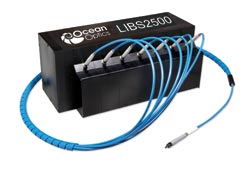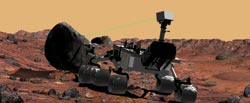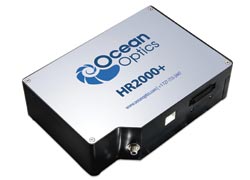Laser-induced breakdown spectroscopy (LIBS) is an important tool in ecological work. It monitors soil contamination and air and water quality. It analyses rocks, meteorites and underwater samples to search for chemicals indicative of life in Earth’s geological record, and it finds use in industrial, biomedical and defence applications. It also analyses a wide range of materials quickly in situ and detects quantities down to tens of parts per million. A noncontact technique, it works in harsh environments.

The LIBS2500plus is a complete broadband LIBS system using up to seven spectrometers to cover the emission spectra for all elements. Courtesy of Ocean Optics Inc.
A more recent development is double-pulse laser-induced breakdown spectroscopy (DP-LIBS), which is even more sensitive and stable than LIBS.
Identifying minerals and elements
When a laser beam interacts with the surface of a sample, it produces plasma; LIBS measures the spectrum of light emitted by the plasma. The technique enables scientists to study many properties of a rock specimen simultaneously. For example, researchers at Masaryk and Brno universities, both in Brno, Czech Republic, mapped the concentrations of calcium, aluminium, iron and manganese across the surface of a piece of granite to find the location and extent of the minerals.
Thanks to a simple setup and sample preparation, LIBS can perform space-resolved, depth-profiled chemical analysis. The technique is “quasi-nondestructive,” removing very small amounts of material from the sample. The investigators used a frequency-doubled Nd:YAG Brilliant B laser from Quantel of Les Ulis, France, with a pulse width of 5 ns and a beam diameter of 8 mm. They collected the plasma radiation with quartz objectives and a 3-m optical fibre and measured it with a Triax 320 from Horiba Jobin Yvon of Longjumeau, France.
The development of real-time, field-portable LIBS instrumentation has greatly advanced the potential for geochemical exploration and environmental monitoring. These instruments detect lead contamination in the soil of former industrial or military sites and help identify appropriate remedial actions. Because all the elements are analysed in a single laser shot, multivariate analyses assist in sorting out the data and in identifying which elements are present.
Life on Mars
In the US, the National Aeronautics and Space Administration’s (NASA) Mars Science Laboratory mission is planning an autumn 2011 launch on an Atlas V 541 rocket. It will assess whether Mars ever has or ever could support microbial life. A rover equipped with a hand lens imager and LIBS instrumentation, and using six cameras to navigate safely over the rocky surface of the planet, will act as a “robotic geologist.”

Shown is an artist’s impression of NASA’s Mars Science Laboratory rover employing LIBS to identify the chemical composition of a rock sample from a distance of up to 8 m. Courtesy of NASA/JPL-Caltech.
The Mars Hand Lens Imager (MAHLI) uses a self-focussing colour camera with visible white and ultraviolet illumination to image features as small as 12.5 μm in rocks and soils. It enables geologists to identify the nature and origin of the minerals. The LIBS instrument, called ChemCam, fires a laser to vaporize material from a 1-mm spot.
A remote microimager and fibre optic direct the emitted light to three spectrographs that analyse the chemical composition of the material.
As part of the preparation for this mission, astronomers and geophysicists have tested LIBS in geological samples at less than 100 ppm to detect any minor elements. They used 10-Hz pulses from an Nd:YAG laser and, from Ocean Optics Inc., HR2000 spectrometers in the ultraviolet, visible and visible near-infrared regions. To emulate the conditions of the Mars mission, they placed the samples in a vacuum chamber with 7-t CO2 and collected the plasma emission with an 89-mm-aperture telescope 9 m away. For use in space, the size, weight, robustness and power consumption of instruments are crucial. The HR2000 and its successor, the HR4000, measure 148.6 × 104.8 × 45.1 mm and weigh 570 g. They have no moving parts, and the HR2000 consumes 95 mA from a 5-VDC supply. Its 2048 pixels lead to an optical resolution of 0.035 nm.

The HR2000 spectrometer is small and robust, with optical resolution to 0.035 nm. Courtesy of Ocean Optics Inc.
Ocean Optics also makes a broadband spectral LIBS system called the LIBS2500+. A single 10-ns laser pulse excites the sample, and up to seven spectrometers simultaneously analyse the spectrum from 200 to 980 nm at 0.1-nm resolution to detect all elements. The system is portable and has a USB interface for connection to a notebook computer. There are two choices of laser: Q-switched 1064-nm Nd:YAG, with either 50 or 200 mJ output. The lower power is suitable for metals and thin films, the latter for glass.
Ancient life forms such as cyanobacteria formed protective biomolecules with specific structural groups that are detectable by Raman spectroscopy, so the European Space Agency will use a miniature instrument that combines that technique and LIBS spectrometry in its ExoMars/AURORA project to search for life on Mars in its 2013 mission. The results also will feed into broader studies of exobiology in the search for life on other planets.
A group of European universities has collected a set of biogeological specimens – with corresponding measurements from a variety of analytical instruments – for future comparison with the Mars results. The samples are from extreme terrestrial environments, such as crater lakes, hydrothermal deposits and volcanistic sediments, which match the sort of geology occurring on Mars.
Double-pulse LIBS
Under certain conditions, the plasma produced in the LIBS technique can be short-lived. In oceanography, for example, the bulk liquid quickly quenches the plasma, giving it a lifetime of about 1 µs, 10 times shorter than that in air. This makes it difficult to detect emission lines from high-energy excited states, restricting the usefulness of LIBS in ocean chemistry. Metals such as iron, zinc, copper and lead are difficult to detect in bulk solution.
In DP-LIBS, a second pulse from an orthogonal laser reheats the plasma, enhancing the intensity of emission and increasing sensitivity to a wider range of elements. In the ocean studies, the two Nd:YAG lasers produced pulses of 5 and 9 ns, respectively, and the researchers studied the effects of elevated pressure on the DP-LIBS measurements. Experiments in a different area of interest have shown the ability to detect small amounts of tin, lead and zinc in copper-based alloys. This work used a nanosecond Nd:YAG laser to reheat the plasma produced by a femtosecond Nd:glass laser.